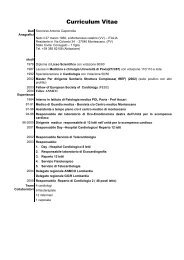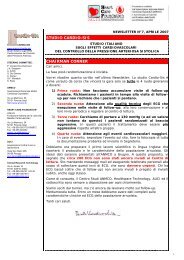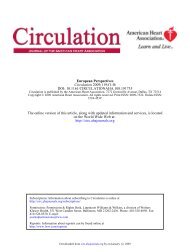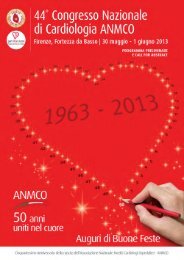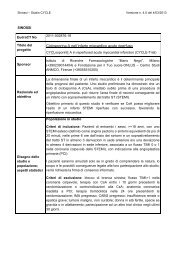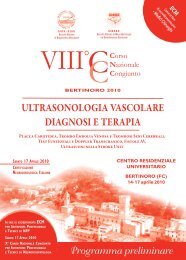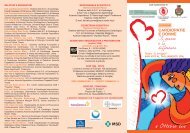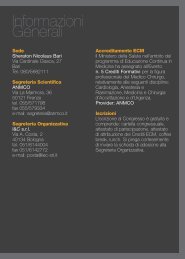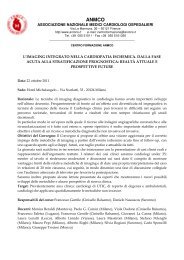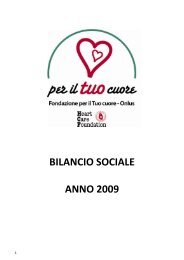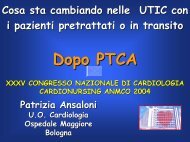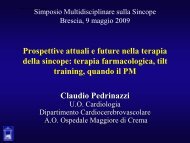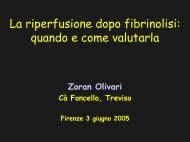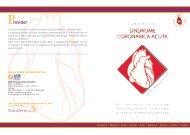Scarica la presentazione - Anmco
Scarica la presentazione - Anmco
Scarica la presentazione - Anmco
Create successful ePaper yourself
Turn your PDF publications into a flip-book with our unique Google optimized e-Paper software.
Sindrome di Brugada<br />
•Ma<strong>la</strong>ttia subcellu<strong>la</strong>re dei canali ionici<br />
(in assenza di cardiopatia organica)<br />
•Ma<strong>la</strong>ttia genetica a trasmissione dominante<br />
-15-30% alterazioni dei canali del Na+ o del Ca2+<br />
(Gene SCN5A ecc.)<br />
-70-85% gene sconosciuto<br />
• Legata ad alterazioni del PAM nel cono di efflusso<br />
del VD<br />
• Si manifesta con alterazioni ecg caratteristiche<br />
(ST sopra derivazioni V1-V3) che mutano nel tempo
Pattern diagnostico<br />
V1<br />
Type 1 Brugada Ecg (coved):<br />
J point >2mm, descendent ST, negative T wave
S. di Brugada tipo 2: ST sopra >2 mm, “saddle back”, T positiva;
Type 3 Brugada ecg: J point>2 mm, ST< 1 mm,<br />
F, 42yrs, asymptomatic. Familial Brugada syndrome ( Proband: syncope,+EPS, ICD)
(F, 42yrs, Familial Brugada syndrome)<br />
AFTER FLECAINIDE
Sindrome di Brugada<br />
E’ diagnostico solo il tipo 1<br />
• Stabile<br />
• Intermittente<br />
• Durante febbre<br />
• In II° spazio intercostale<br />
• Dopo farmaci c<strong>la</strong>sse 1<br />
Tipo 1 spontaneo<br />
Tipo 1 indotto
Febbre, 25.9.07 36.5°, 28.9.07
D.C. aa 53, Sindrome di Brugada familiare, una morte improvvisa<br />
(nipote di I° grado, MI a 26 anni)
C.D. aa 53. Derivazioni precordiali in II° spazio intercostale
Sindrome di Brugada tipo 1<br />
• Alterazioni ecg aspecifiche<br />
• Ma<strong>la</strong>ttia aritmogena del ventricolo destro (MAVD)<br />
• Miocardite<br />
Diagnosi differenziale<br />
• Cardiomiopatie idiopatiche<br />
• Compressione estrinseca del cono di efflusso del<br />
ventricolo destro<br />
• Sindrome coronarica acuta<br />
• ….
Kakishita M et al. J Am Coll Cardiol 2000; 36:1646-53
S. Di BRUGADA<br />
STRATIFICAZIONE<br />
DEL<br />
RISCHIO
Priori S. et al., Circu<strong>la</strong>tion 2002; 105:1342-7
Sindrome di Brugada<br />
Valore dello studio elettrofisiologico<br />
• Qual’e’ <strong>la</strong> sensibilita’ e specificita’<br />
• Quale il valore predittivo<br />
• Quale ruolo ha nel<strong>la</strong> stratificazione del<br />
rischio
SENSIBILITA’ DELLO SEE NELLA S. DI BRUGADA<br />
(Brugada P et al. J Cardiovasc Electrophysiol 2003;14: 455-457)<br />
Totale: 443
Non inducible<br />
Inducible<br />
Brugada P et al. J Cardiovasc Electrophysiol 2003;14: 455-457
(F.u. 34+/-40 moths)<br />
Brugada P et al. J Cardiovasc Electrophysiol 2003;14: 455-457
Determinants of SD in individuals with the Ecg pattern of<br />
Brugada Syndrome and no previous cardiac arrest<br />
Brugada J, R and P. Circu<strong>la</strong>tion 2003; 108:3092-3096<br />
Analisi Multivariata p<br />
OR<br />
Inducibilita’ 5.88 0.0001<br />
Sincope 2.5 0.017<br />
Tipo 1 basale 2.86 0.103<br />
Casistica: 547 casi, 72% tipo 1 basale
Risk stratification of individuals with the Brugada electrocariogram: a<br />
meta-analysis<br />
(Gehi AK et al .J Cardiovasc Electrophysiol 2006; 17:577-583)
320<br />
(80% M)<br />
42+/-14 yrs<br />
176 (55%) tipo 1<br />
spontaneo<br />
144 (45%) tipo1C<br />
105 Sintomatici<br />
(33%)<br />
215 Asintomatici<br />
(67%)<br />
Casistica: Conegliano, Asti, Roma, Udine, Portogruaro
Inducibilita’ di TV/FV con lo SEE<br />
(Delise et al. 2009)<br />
n. SEE + %<br />
SINTOMATICI<br />
98<br />
46/98<br />
47%<br />
•escluse sincopi<br />
neuromediate<br />
56<br />
42/56<br />
75%<br />
ASINTOMATICI 146 50/146 34%
Follow up: mediana 3 anni (IQ 0.9-4.7)<br />
320<br />
105 Sintomatici<br />
(33%)<br />
215 Asintomatici<br />
(67%)<br />
11 FV 3 morte improvvisa 3 FV<br />
10% 3%
Risk stratification<br />
%<br />
100<br />
90<br />
80<br />
70<br />
60<br />
50<br />
40<br />
30<br />
20<br />
10<br />
0<br />
(log-rank test p=0.0001)<br />
tipo 1 spontaneo<br />
tipo 1C<br />
Median (IQ) follow-up length: () months<br />
1000 2000 3000 4000 5000 6000<br />
Days
FAMILIARITA’ PER<br />
MORTE<br />
IMPROVVISA<br />
SINCOPI<br />
TIPO 1<br />
SPONTANEO<br />
SEE +
Familiarità in 176 pts<br />
con ECG tipo 1 spontaneo<br />
surviving(%)<br />
100<br />
90<br />
80<br />
70<br />
60<br />
50<br />
40<br />
30<br />
20<br />
10<br />
0<br />
(log-rank test p=0.17)<br />
FAM -<br />
FAM +<br />
Median (IQ) follow-up length: 40(20-67) months<br />
2 4 8 10 12 14<br />
years
Sincope in 176 pts<br />
con ECG tipo 1 spontaneo<br />
surviving(%)<br />
100<br />
90<br />
80<br />
70<br />
60<br />
50<br />
40<br />
30<br />
20<br />
10<br />
0<br />
(log-rank test p=0.05)<br />
syncope -<br />
syncope +<br />
Median (IQ) follow-up length: 40(20-67) months<br />
2 4 8 10 12 14<br />
years
100<br />
90<br />
80<br />
70<br />
60<br />
50<br />
40<br />
30<br />
20<br />
10<br />
0<br />
EPS in 141 pts<br />
with spontaneous type 1 ECG<br />
EPS -<br />
EPS +<br />
Median (IQ) follow-up length: () months<br />
1000 2000 3000 4000 5000 6000<br />
Days<br />
(log-rank test p=0.0003)
EPS in pts with spontaneous type 1 ECG<br />
n. VF PPV NPV<br />
• +EPS 71 13 18%<br />
• -EPS 70 0 100%<br />
Median follow-up length: 3.0 yrs (IQ 0.9-4.7)
%<br />
100<br />
90<br />
80<br />
70<br />
60<br />
50<br />
40<br />
30<br />
20<br />
10<br />
0<br />
Risk stratification in 141 pts<br />
with spontaneous type 1 ECG<br />
0 fattori di rischio<br />
1 fattori di rischio<br />
2 fattori di rischio<br />
3 fattori di rischio<br />
1000 2000 3000 4000 5000 6000<br />
Days<br />
(log-rank test p=0.0001)<br />
Median (IQ) follow-up length: () months
Outcome of patients followed for primary prevention of SD<br />
Delise P 2009<br />
n.320<br />
Sarkozy A 2007<br />
n.47<br />
Major events 17 7<br />
Spontaneous 17 (100%) 7 (100%)<br />
type 1<br />
Previous<br />
11 (65%) 3 (43%)<br />
syncope<br />
FAM+ 7 (41%) 3 (43%)<br />
EPS+ 13/13 (100%) 7 (100%)
CONCLUSIONI<br />
• Il rischio di morte improvvisa nel<strong>la</strong> s. di Brugada<br />
va valutato in modo poliparametrico<br />
• I pazienti con tipo 1 spontaneo rappresentano una<br />
categoria a rischio diverso rispetto al tipo 1 C<br />
• La positivita’ dello SEE e’ un fattore di rischio<br />
maggiore ma deve essere associata ad altri<br />
elementi ( ecg tipo 1 spontaneo, familiarita’,<br />
sincope)
REBUTTAL<br />
I motivi delle<br />
discrepanze in letteratura
Long-term follow up of primary prophy<strong>la</strong>ctic ICD therapy in Brugada Syndrome<br />
(Sarkozy A et al, Eur Heart J 2007;28: 334-344)<br />
47 patients: syncope and/or familial SD and/or EPS +<br />
EPS+: 83%
Determinants of SD in individuals with the Ecg pattern of<br />
Brugada Syndrome and no previous cardiac arrest<br />
Brugada J, R and P. Circu<strong>la</strong>tion 2003; 108:3092-3096<br />
Totale (M) 547 (408)<br />
Eta’ 41+/-15<br />
Tipo 1 basale 72%<br />
Storia familiare di SD 55%<br />
Asintomatici 78%<br />
Inducibilita’ allo SEE 40%<br />
Eventi nel follow up (24+/-32 mesi) 8%
Stratificazione multiparametrica del rischio<br />
Ecg tipo 1 basale<br />
Sincope EPS+ % eventi<br />
(f.u. 24+/-32 mesi)<br />
SI SI 27%<br />
NO SI 14%<br />
SI NO 4%<br />
NO NO 2%<br />
Brugada J, R and P. Circu<strong>la</strong>tion 2003; 108:3092-3096
Stratificazione multiparametrica del rischio<br />
Ecg tipo 1dopo farmaci 1 C<br />
Sincope EPS+ % eventi<br />
(f.u. 24+/-32 mesi)<br />
SI SI 10%<br />
NO SI 5%<br />
SI NO 1%<br />
NO NO 0.5<br />
Brugada J, R and P. Circu<strong>la</strong>tion 2003; 108:3092-3096
Role of programmed ventricu<strong>la</strong>r stimu<strong>la</strong>tion (PVS) in pts with<br />
Brugada syndrome: a meta-analysis of worldwide published data.<br />
Paul M et al Eur Heart J 2007; 28:2126-2133<br />
Tot. Eckardt 2005 Priori 2002<br />
n. 774 212 200<br />
Tipo 1 base 66% 59% 51%<br />
MI familiare 14% 1.2% N.D.<br />
Asintomatici 59% 58% 72%<br />
SEE + 55% 50% 66%<br />
Follow up 34+/-40 40+/-50 34+/-44 mo<br />
Eventi 76 (9%) 9 (4%) 13 (6%)
Role of programmed ventricu<strong>la</strong>r stimu<strong>la</strong>tion (PVS) in pts with<br />
Brugada syndrome: a meta-analysis of worldwide published data.<br />
Paul M et al Eur Heart J 2007; 28:2126-2133<br />
Inducibility of<br />
sVT by PVS<br />
OR<br />
All studies 1.495<br />
(1.63-4.06)<br />
Brugada et al 2003 10.002<br />
(3.81-26.23)<br />
p<br />
0.399<br />
Sindrome di Brugada<br />
Pattern ecg di Brugada tipo 1<br />
• Fenotipo che accomuna pazienti con<br />
caratteristiche cliniche diverse<br />
• Fenotipo che accomuna probabilmente<br />
mutazioni genetiche diverse<br />
• Problema maggiore: stratificazione del rischio<br />
nei singoli soggetti
Sindrome di Brugada<br />
Valore dello studio elettrofisiologico<br />
• Ha una elevata sensibilita’ nei pazienti con alta<br />
vulnerabilita’ ventrico<strong>la</strong>re<br />
• Il valore predittivo positivo dipende dal<strong>la</strong><br />
categoria di pazienti studiati<br />
• Pur essendo un fattore di rischio indipendente<br />
(secondo Brugada) va integrato con gli altri fattori<br />
indipendenti di rischio
D.R. 42 aa. Fratello morto improvvisamente a 40 anni.<br />
Asintomatico. Scoperta casuale di ST sopra in V1-V2 “coved”.
D.R. a 42. SEE: induzione di f.v.
Dopo 2 mesi dall’impianto di ICD
SEE<br />
244<br />
Sintomatici<br />
98<br />
Asintomatici<br />
146<br />
•Tipo 1 spontaneo 61<br />
•1 C 37<br />
•Tipo 1 spontaneo 80<br />
•1 C 66<br />
Casistica: Conegliano, Asti, Roma, Udine, Portogruaro
%<br />
100<br />
90<br />
80<br />
70<br />
60<br />
50<br />
40<br />
30<br />
20<br />
10<br />
0<br />
EPS in asymptomatic 80 pts<br />
with spontaneous type 1 ECG<br />
EPS -<br />
EPS +<br />
(log-rank test p=0.062)<br />
Median (IQ) follow-up length: () months<br />
500 1000 2000 3000 4000<br />
Days
Median follow-up length: 3.0 yrs (IQ 0.9-4.7)<br />
110 ICD<br />
19 ICD<br />
14 APPROPRIATE<br />
SHOCKS ON VF<br />
12 INAPPROPRIATE<br />
SHOCKS<br />
- 4 Atrial fibril<strong>la</strong>tion/TG<br />
- 4 Sinusal tachicardia<br />
- 1 Oversensing of T-wave<br />
3 lead failure
Caratteristiche cliniche basali dei 17 pts<br />
con eventi maggiori<br />
SEX<br />
SPONTANEOUS<br />
TYPE 1<br />
FAM + SINCOPE SEEF +<br />
M YES NO NO -<br />
M YES YES YES YES<br />
M YES NO YES YES<br />
M YES NO YES YES<br />
M YES NO YES YES<br />
M YES NO YES YES<br />
M YES NO YES YES<br />
F YES YES YES YES<br />
M YES YES NO YES
Caratteristiche cliniche basali dei 17 pts<br />
con eventi maggiori<br />
SEX<br />
SPONTANEOUS<br />
TYPE 1<br />
FAM<br />
+<br />
SINCOPE SEEF +<br />
M YES YES YES YES<br />
M YES YES NO -<br />
M YES NO YES -<br />
M YES NO NO -<br />
M YES YES NO YES<br />
F YES NO YES YES<br />
M YES YES NO YES<br />
M YES NO YES YES



